I'll carefully craft unique headings that capture the essence of each Japandi bedroom design concept, ensuring variety and specificity while maintaining the core principles of minimalism and functional beauty.Transform your bedroom into a serene sanctuary where Japanese minimalism meets Scandinavian warmth. Japandi bedroom design creates the perfect balance between functionality and tranquility, combining clean lines with natural textures and neutral tones. This aesthetic emphasizes quality over quantity, featuring carefully curated elements that promote rest and relaxation. The style focuses on natural materials like wood, bamboo, and linen while maintaining uncluttered spaces that breathe calmness into your daily routine. Whether you're seeking complete transformation or subtle enhancements, these design ideas will guide you toward creating a peaceful retreat that embodies both Eastern simplicity and Nordic coziness.
1. Japandi Bedroom Low-Profile Platform Beds
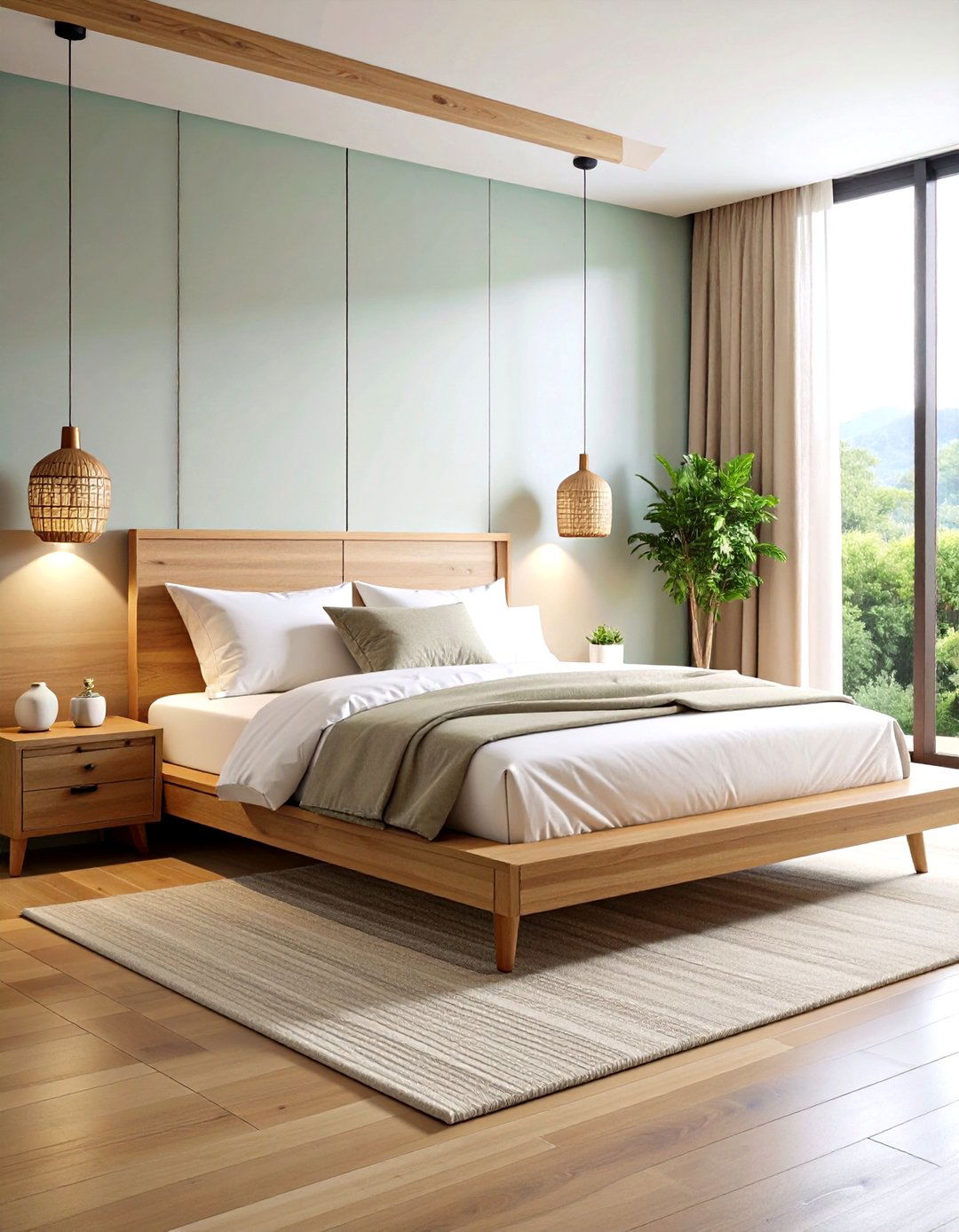
Transform your sleep space with a low-profile platform bed that embodies the essence of Japanese design philosophy. These minimalist frames sit close to the ground, creating an open, spacious feeling while promoting the traditional Japanese connection to earth and nature. Choose solid wood construction in oak, ash, or walnut with clean, geometric lines and minimal hardware. The low height makes your ceiling appear higher while maintaining the uncluttered aesthetic essential to Japandi style. Pair with crisp white or neutral linen bedding to enhance the serene atmosphere. Platform beds often include integrated storage drawers, maximizing functionality without compromising the minimalist design. This foundational piece anchors your room while supporting the peaceful, grounded energy that makes Japandi bedrooms so restorative and calming.
2. Japandi Bedroom Natural Lighting Solutions
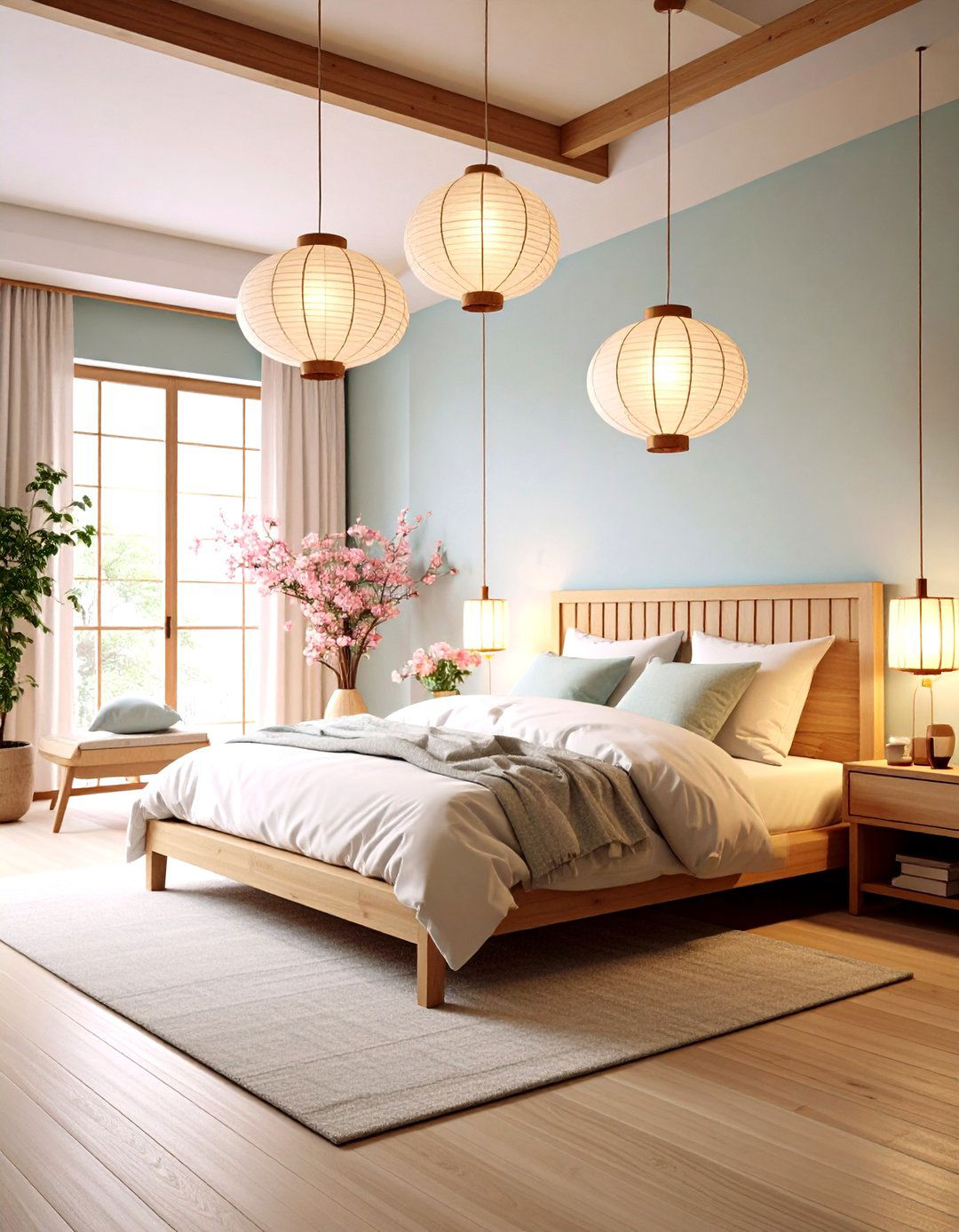
Embrace the art of ambient illumination through carefully curated natural lighting elements that define authentic Japandi bedroom design. Traditional Japanese paper lanterns provide soft, diffused light that creates a warm, cocoon-like atmosphere perfect for evening relaxation. Consider installing rice paper pendant lights or table lamps with wooden bases crafted from bamboo or light oak. Layer different light sources including floor lamps with linen shades and wall sconces with frosted glass to achieve optimal ambiance. Prioritize warm LED bulbs that mimic natural daylight, supporting circadian rhythms and promoting better sleep quality. Avoid harsh overhead lighting in favor of multiple gentle sources that can be dimmed according to your needs. Strategic placement of mirrors near windows amplifies natural daylight, creating an airy, spacious feeling throughout the day while maintaining the serene energy essential to Japandi aesthetics.
3. Japandi Bedroom Built-In Storage Systems

Maximize space efficiency while maintaining visual calm through thoughtfully designed built-in storage solutions that seamlessly integrate into your bedroom walls. Custom wardrobes with sliding shoji-style doors eliminate visual clutter while providing ample space for clothing and personal items. Consider floor-to-ceiling units with a mix of open shelving and closed compartments, allowing you to display carefully chosen ceramic pieces or books while concealing everyday necessities. Built-in window seats with hidden storage underneath offer additional seating and organization options. Choose light wood finishes or painted surfaces in soft neutral tones that blend with your wall color. Incorporate LED strip lighting within shelving to illuminate displayed objects and create depth. These permanent solutions reduce the need for additional furniture pieces, maintaining the uncluttered aesthetic while ensuring everything has its designated place, supporting the minimalist philosophy central to Japandi design principles.
4. Japandi Bedroom Neutral Color Palettes
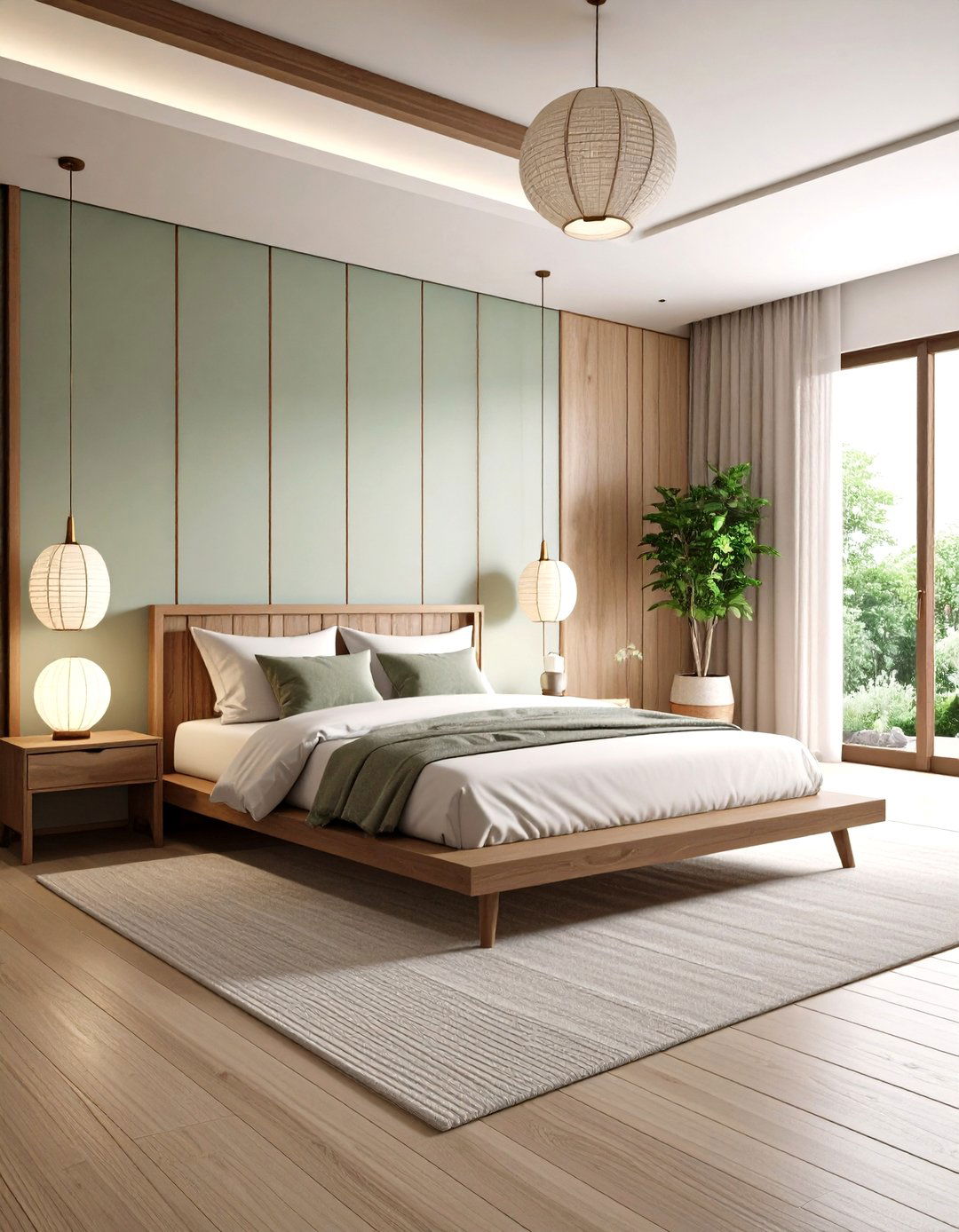
Create a foundation of tranquility through carefully selected neutral color schemes that capture the essence of both Japanese and Scandinavian design philosophies. Begin with soft whites and warm beiges as your base, then layer in muted grays, sage greens, and dusty blues for subtle depth. Consider paint colors like warm white, mushroom gray, or soft taupe for walls, ensuring they complement natural light throughout the day. Introduce earthy accents through terracotta or clay-colored textiles and accessories while maintaining the overall monochromatic harmony. Use the 60-30-10 rule: sixty percent dominant neutral, thirty percent secondary tone, and ten percent accent color. Dark wood tones and black accents provide grounding elements without overwhelming the peaceful atmosphere. This restrained palette promotes relaxation and creates a timeless backdrop that allows natural textures and materials to shine while supporting restful sleep and mental clarity.
5. Japandi Bedroom Natural Texture Layering

Develop visual and tactile interest through sophisticated layering of natural textures that bring warmth to minimalist Japandi bedroom spaces. Combine smooth wooden surfaces with woven elements like jute rugs, linen curtains, and wool throws to create depth without visual chaos. Introduce bamboo blinds, rattan baskets, or seagrass floor coverings that add organic appeal while maintaining clean lines. Layer different fabric weights and weaves in bedding: crisp cotton sheets, nubby linen duvet covers, and chunky knit blankets in coordinating neutral tones. Consider textured wallpaper or limewash paint techniques that add subtle surface interest to accent walls. Natural stone elements like slate coasters or marble accessories provide cool contrast to warm wood tones. Mix polished and rough-hewn finishes to create visual rhythm while honoring the wabi-sabi philosophy of finding beauty in imperfection. These varied textures engage the senses while supporting the calming, nature-connected atmosphere essential to authentic Japandi design.
6. Japandi Bedroom Minimalist Furniture Selection

Curate essential furniture pieces that embody both form and function while maintaining the uncluttered aesthetic central to Japandi bedroom design. Choose a streamlined dresser with clean geometric lines and minimal hardware, preferably crafted from light woods like birch or maple. Select nightstands that offer discrete storage through drawers or shelving while maintaining proportional balance with your bed frame. Consider a simple wooden bench at the foot of your bed for both seating and storage of extra linens. Opt for furniture with rounded edges and organic shapes that soften the overall geometric composition. Each piece should serve multiple purposes while maintaining visual lightness through raised legs or floating designs that allow floor space to show beneath. Quality craftsmanship and natural materials take precedence over quantity, ensuring every item contributes meaningfully to the room's peaceful atmosphere while supporting your daily routines with thoughtful functionality.
7. Japandi Bedroom Plant Integration Systems

Bring life and natural energy into your bedroom through carefully selected plants that thrive in indoor environments while supporting air purification and mental wellbeing. Choose low-maintenance varieties like snake plants, ZZ plants, or peace lilies that tolerate lower light conditions and irregular watering schedules. Display plants in handcrafted ceramic planters or natural fiber baskets that complement your neutral color palette. Create a dedicated plant corner with a wooden plant stand or floating shelves at varying heights to establish visual hierarchy. Consider hanging plants like pothos or spider plants to add vertical interest without consuming floor space. Small bonsai trees or succulent arrangements on nightstands provide intimate natural connections. Group plants in odd numbers and vary their sizes and shapes for organic appeal. This living element softens hard surfaces while improving indoor air quality and creating a stronger connection to nature, essential components of authentic Japandi design philosophy.
8. Japandi Bedroom Paper Lantern Lighting
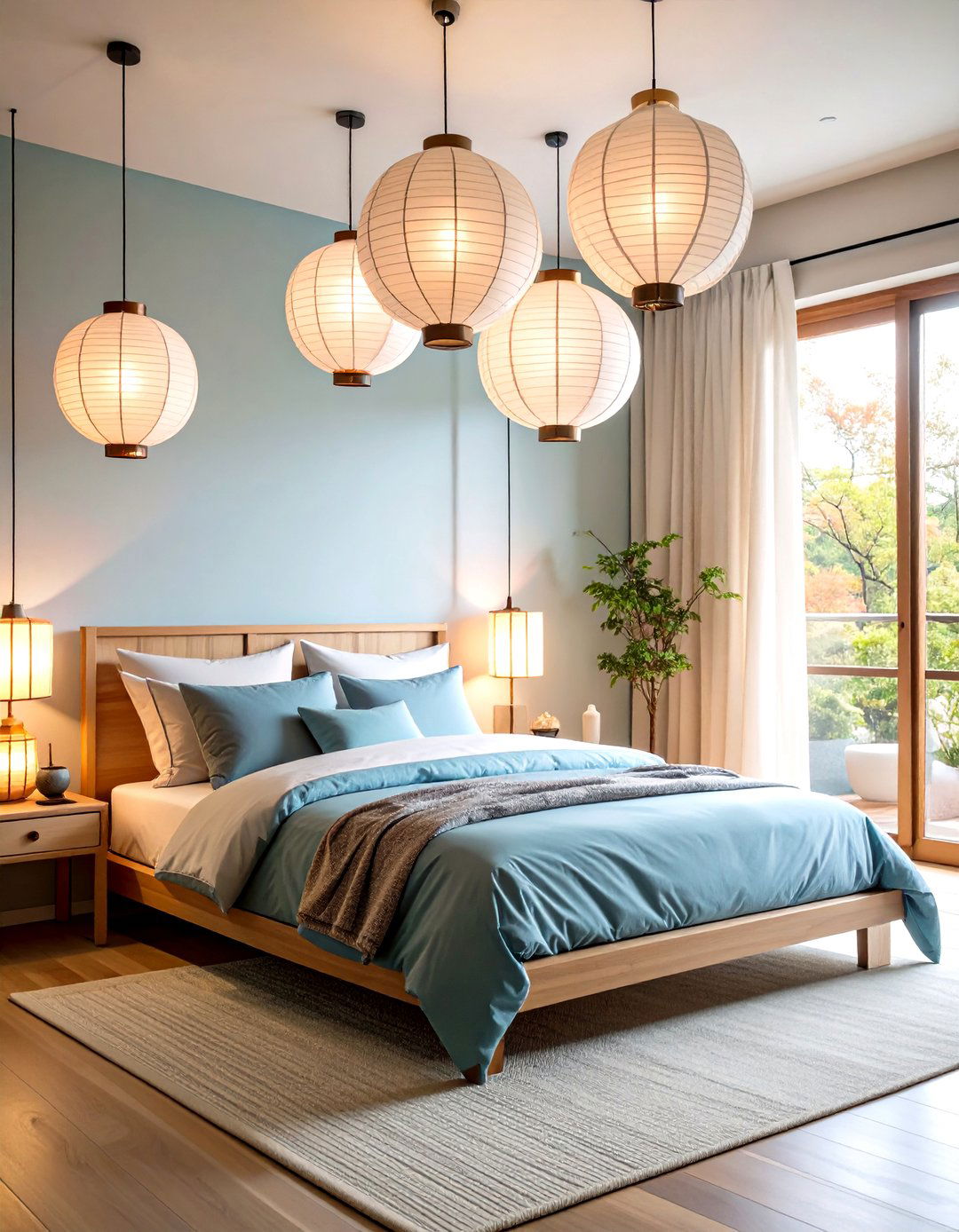
Illuminate your space with traditional Japanese paper lanterns that provide soft, diffused lighting perfect for creating a serene bedtime atmosphere. Install pendant-style paper lanterns at varying heights to create visual interest while maintaining the clean, uncluttered aesthetic. Choose spherical or cylindrical shapes in natural white or warm cream tones that complement your neutral color palette. Table-mounted paper lanterns on nightstands or dressers offer intimate task lighting for reading or relaxation. Consider floor-standing paper lamp models that can be moved as needed while providing ambient illumination throughout the room. These luminaires create gentle shadows that add depth and warmth without harsh glare. Pair with dimmer switches to control intensity according to time of day and activities. The translucent quality of paper allows light to filter softly, promoting relaxation and supporting natural circadian rhythms while honoring traditional Japanese design elements that make Japandi bedrooms uniquely peaceful and restorative.
9. Japandi Bedroom Wood Slat Accent Walls
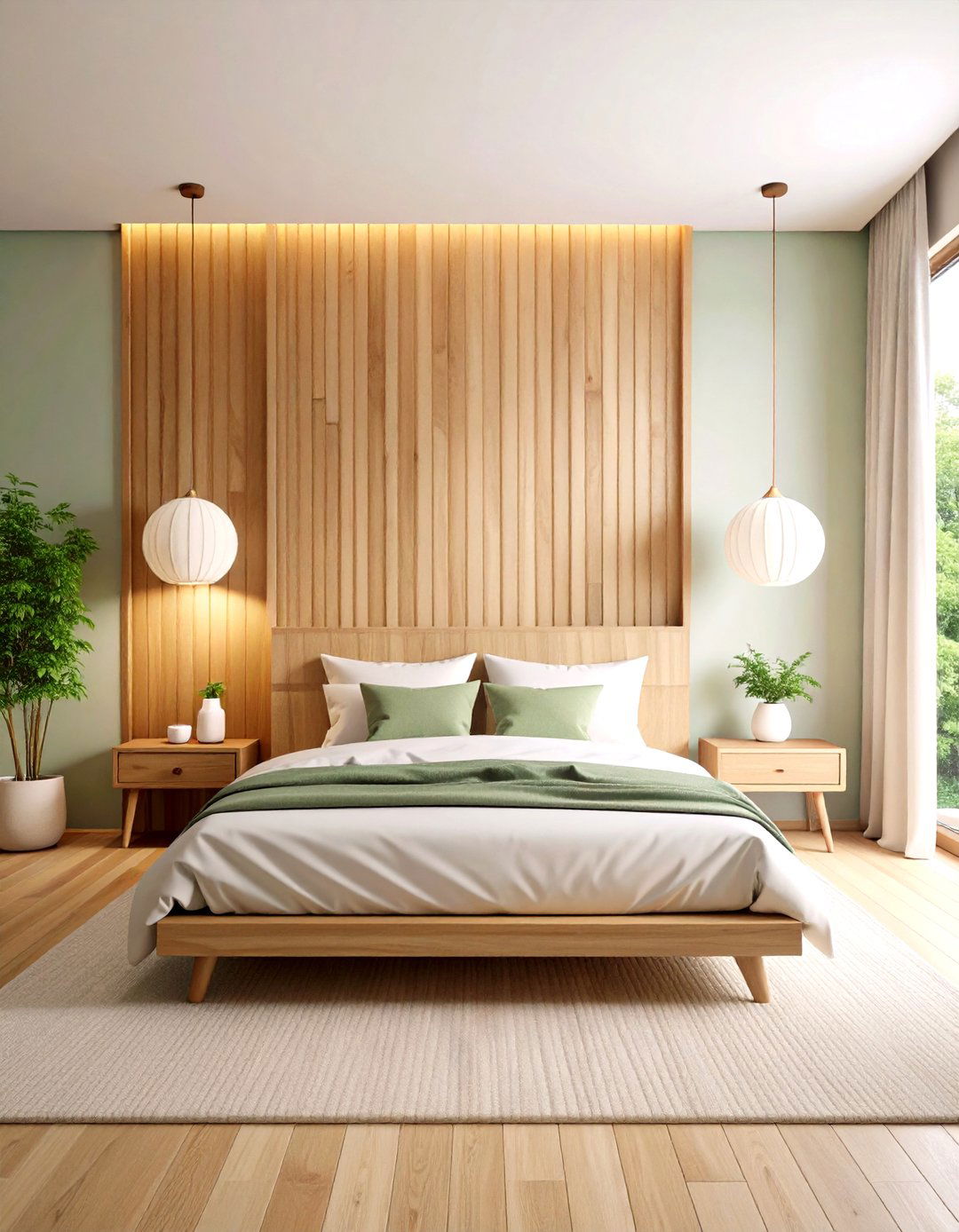
Create a striking focal point through carefully designed wood slat accent walls that add texture and warmth while maintaining clean, geometric lines. Install vertical or horizontal wooden slats with consistent spacing to create rhythm and visual interest behind your bed or on a feature wall. Choose light woods like ash, maple, or pine that complement your existing furniture while adding natural warmth to the space. Vary slat widths subtly or incorporate integrated LED lighting between slats for dramatic evening ambiance. Consider floating the slats slightly away from the wall to create shadow lines that add depth and dimension. This technique works particularly well in smaller bedrooms where it creates the illusion of expanded space. The linear patterns support the minimalist aesthetic while introducing organic material that connects the indoor space to nature. Proper installation ensures longevity while the natural wood aging gracefully over time, embodying the wabi-sabi appreciation for material evolution and impermanence.
10. Japandi Bedroom Tatami Mat Flooring
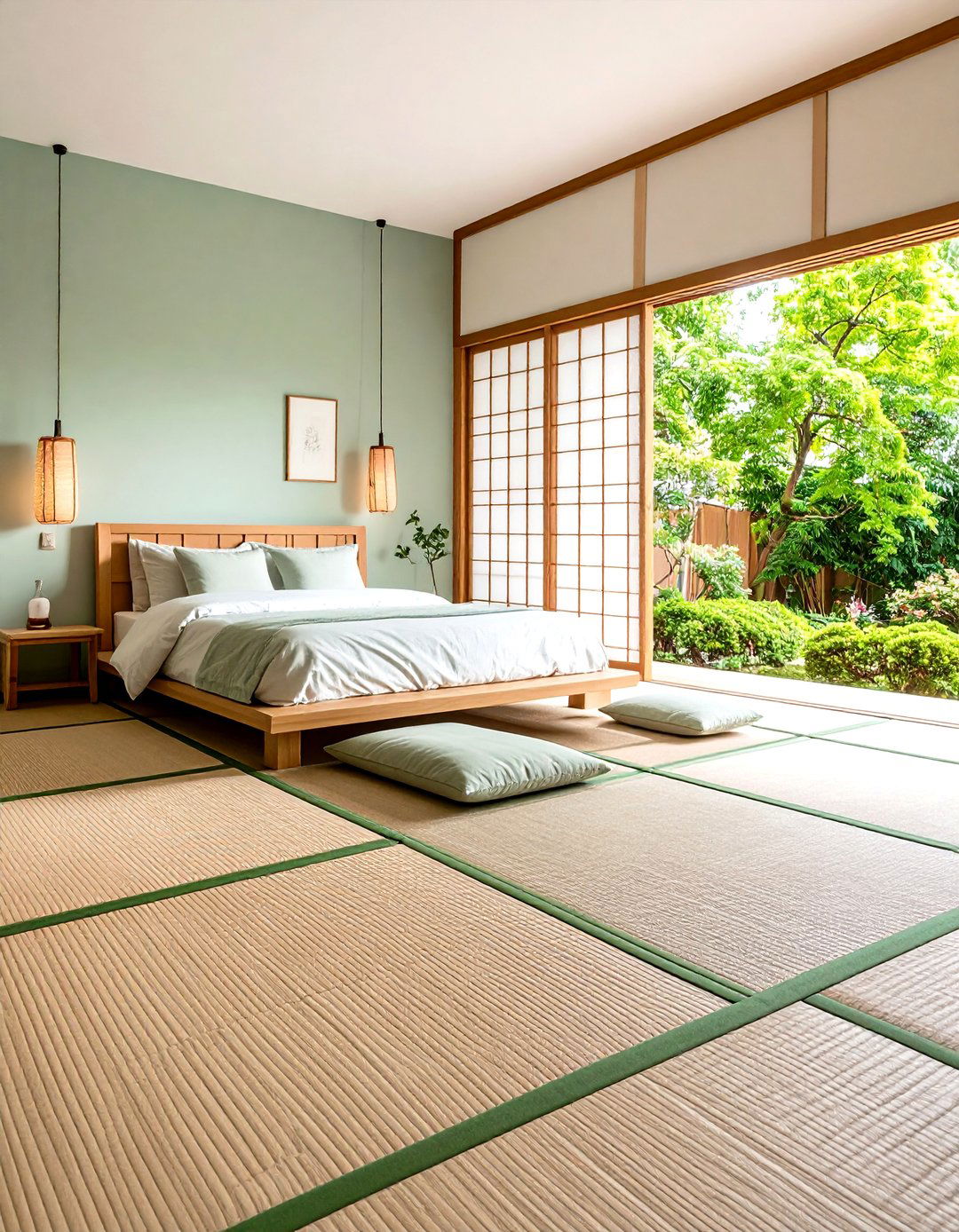
Incorporate traditional Japanese tatami mats to create authentic flooring that supports the minimalist aesthetic while providing natural texture and comfort underfoot. Use tatami mats as area rugs beneath your bed or to define specific zones within larger bedrooms. These woven rush mats offer natural antimicrobial properties and regulate humidity while adding subtle geometric patterns through their traditional rectangular proportions. Layer tatami mats over hardwood floors or use them to soften concrete surfaces in modern bedrooms. Their neutral beige and green tones complement any Japandi color palette while providing a connection to Japanese cultural traditions. Consider custom-sized mats that fit your specific space requirements or create interesting compositions through strategic placement of multiple smaller mats. The natural fibers age beautifully, developing a patina that embodies wabi-sabi principles. Regular maintenance involves simple vacuuming and occasional sunning to maintain freshness and longevity, making them practical as well as aesthetically pleasing flooring solutions.
11. Japandi Bedroom Floating Shelf Systems

Maximize storage while maintaining visual lightness through strategically placed floating shelves that appear to suspend effortlessly from your walls. Install shelves at varying heights to create dynamic compositions while providing space for books, ceramics, and carefully chosen decorative objects. Choose materials that match your existing wood furniture or opt for painted finishes that blend seamlessly with wall colors. Maintain consistent spacing between shelves to create visual rhythm and balance throughout the room. Use shelves to display meaningful objects that reflect your personal journey while adhering to minimalist principles of quality over quantity. Consider incorporating integrated LED lighting beneath shelves to illuminate displayed items and create ambient evening glow. Group objects in odd numbers and leave generous white space between items to prevent visual clutter. These storage solutions eliminate the need for additional furniture pieces while maintaining the open, airy feeling essential to Japandi bedroom design while supporting organized, mindful living practices.
12. Japandi Bedroom Linen Bedding Layers
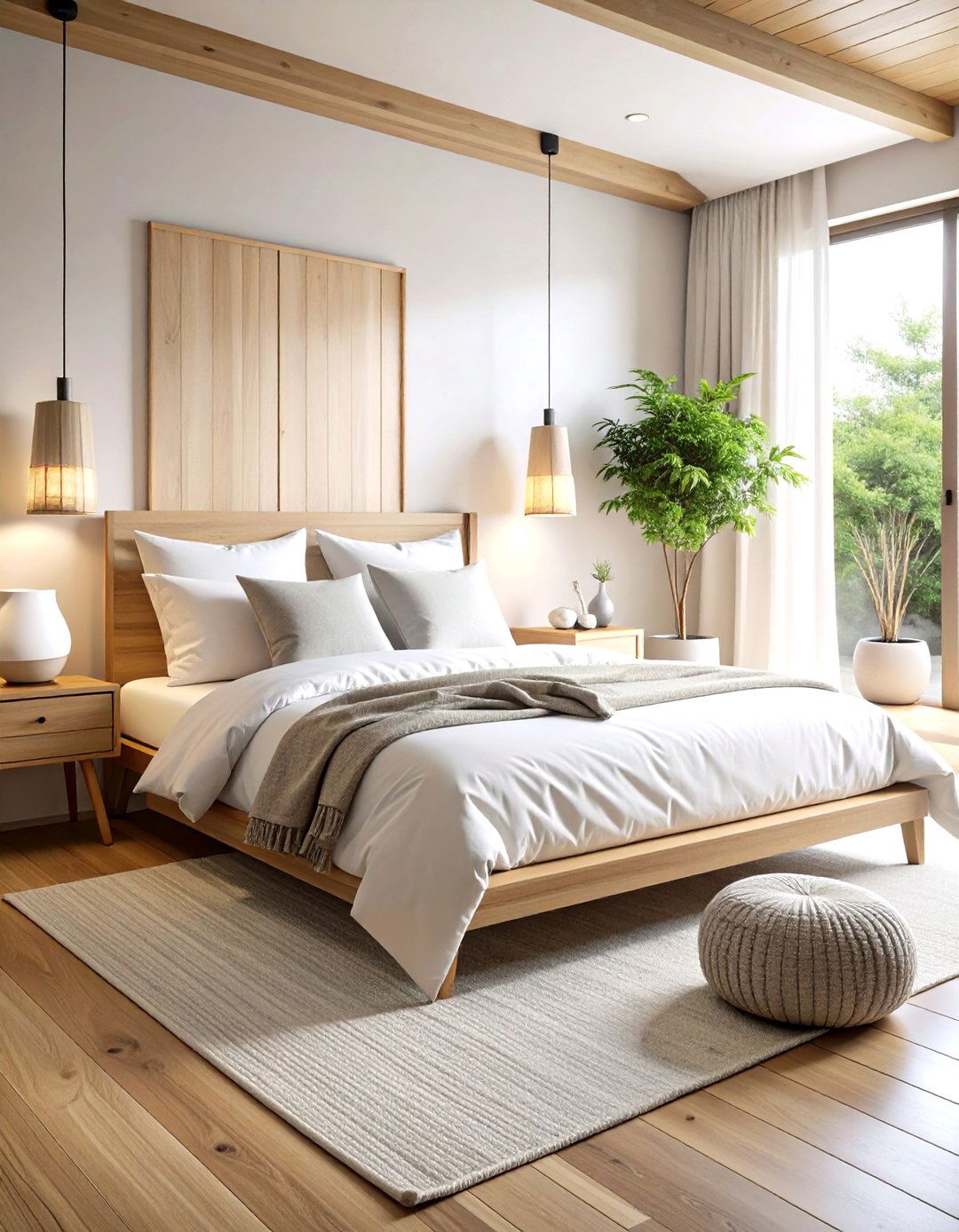
Achieve ultimate comfort and visual sophistication through thoughtfully layered natural linen bedding that embodies the relaxed elegance of Japandi design. Start with pure linen sheets in neutral tones like warm white, soft gray, or natural beige that improve with each washing, developing a lived-in softness. Layer a linen duvet cover over a down or down-alternative comforter for temperature regulation and easy care. Add texture through different linen weaves: smooth percale sheets, slightly textured duvet covers, and chunky linen throw pillows. Include a lightweight linen blanket for shoulder seasons and a heavier wool throw for winter warmth. Choose coordinating but not matching tones to create subtle visual interest while maintaining cohesive color harmony. The natural wrinkled texture of linen embraces wabi-sabi imperfection while providing breathable comfort. Quality linen bedding improves over time, supporting the Japandi philosophy of investing in lasting materials that age gracefully while promoting restful sleep.
13. Japandi Bedroom Earth Tone Accent Integration

Introduce warmth and depth through carefully selected earth tone accents that complement your neutral base while maintaining the serene Japandi aesthetic. Incorporate soft terracotta through ceramic vessels, clay-colored throw pillows, or rust-toned artwork that connects your space to natural elements. Add sage green through plants, textiles, or small furniture pieces that evoke forest tranquility. Consider dusty blue accents through ceramics or artwork that suggests sky and water elements. Use these colors sparingly as the ten percent accent portion of your color scheme, ensuring they enhance rather than dominate your peaceful palette. Natural materials in these tones work best: unglazed pottery, naturally dyed textiles, or stone accessories that reflect authentic earth connections. Seasonal rotation of accent pieces allows you to refresh your space while maintaining core design principles. These warm tones provide psychological comfort while supporting the biophilic design elements that make Japandi bedrooms particularly restorative and connected to natural rhythms.
14. Japandi Bedroom Zen Meditation Corners
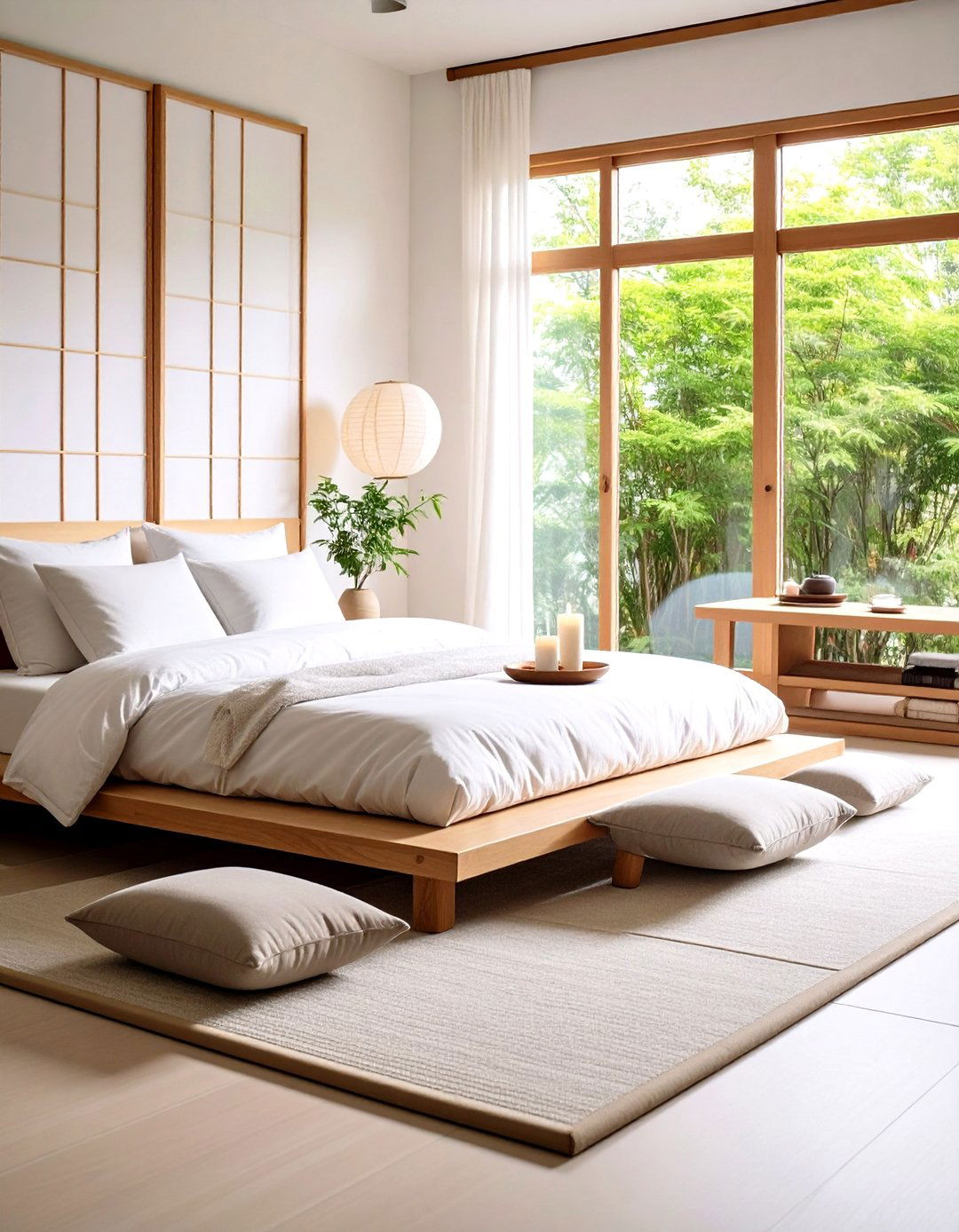
Designate a peaceful corner specifically for meditation, reading, or quiet reflection that supports your mental wellbeing and spiritual practice. Create this sanctuary using a low zabuton cushion or meditation bench positioned near a window with natural light. Add a small wooden side table or floating shelf to hold meaningful objects like stones, candles, or a simple ceramic vessel. Consider a small indoor plant or bamboo element to strengthen the natural connection. Keep this area completely free from technology and distractions, using soft natural light or a single candle for evening practice. Choose neutral textiles and natural materials that blend seamlessly with your overall bedroom design while creating a distinct zone for contemplation. Include a small basket for storing meditation accessories or journals. This dedicated space reinforces the mindful living principles central to Japandi philosophy while providing a retreat within your retreat for daily practices that support emotional balance and mental clarity.
15. Japandi Bedroom Multifunctional Furniture Pieces

Maximize space efficiency through carefully selected furniture that serves multiple purposes while maintaining the clean, uncluttered aesthetic essential to Japandi design. Choose an ottoman with hidden storage that functions as seating, a footrest, and organization solution for extra bedding or seasonal items. Select a bed frame with integrated drawers beneath for storing linens, clothing, or personal items out of sight. Consider a writing desk that doubles as a vanity with a removable or fold-away mirror to support multiple daily activities. Invest in a bench with lift-up storage positioned at the foot of your bed for both seating and blanket storage. Look for nightstands with charging stations, drawers, and open shelving to consolidate bedside necessities. These pieces reduce visual clutter while maximizing functionality, supporting the Japandi principle of purposeful, mindful living. Quality construction ensures longevity while thoughtful design maintains the peaceful, organized atmosphere that makes Japandi bedrooms particularly restful and efficient living spaces.
16. Japandi Bedroom Natural Window Treatment Solutions

Frame your windows with natural materials and clean lines that filter light beautifully while maintaining privacy and temperature control. Install bamboo Roman shades that provide texture and warmth while offering adjustable light control throughout the day. Layer with simple linen curtains in neutral tones that can be drawn for complete privacy or tied back to maximize natural light. Consider wooden blinds with wide slats that create interesting shadow patterns while maintaining the minimalist aesthetic. Avoid heavy drapery or complex valances that compete with the clean lines essential to Japandi design. Choose hardware in matte black or natural wood finishes that complement your existing furniture pieces. The goal is to enhance natural light while providing functional control over privacy and glare. These treatments should feel effortless and integrated rather than decorative, supporting the overall sense of calm and connection to the outdoors that makes Japandi bedrooms particularly peaceful and restorative living environments.
17. Japandi Bedroom Handcrafted Ceramic Displays
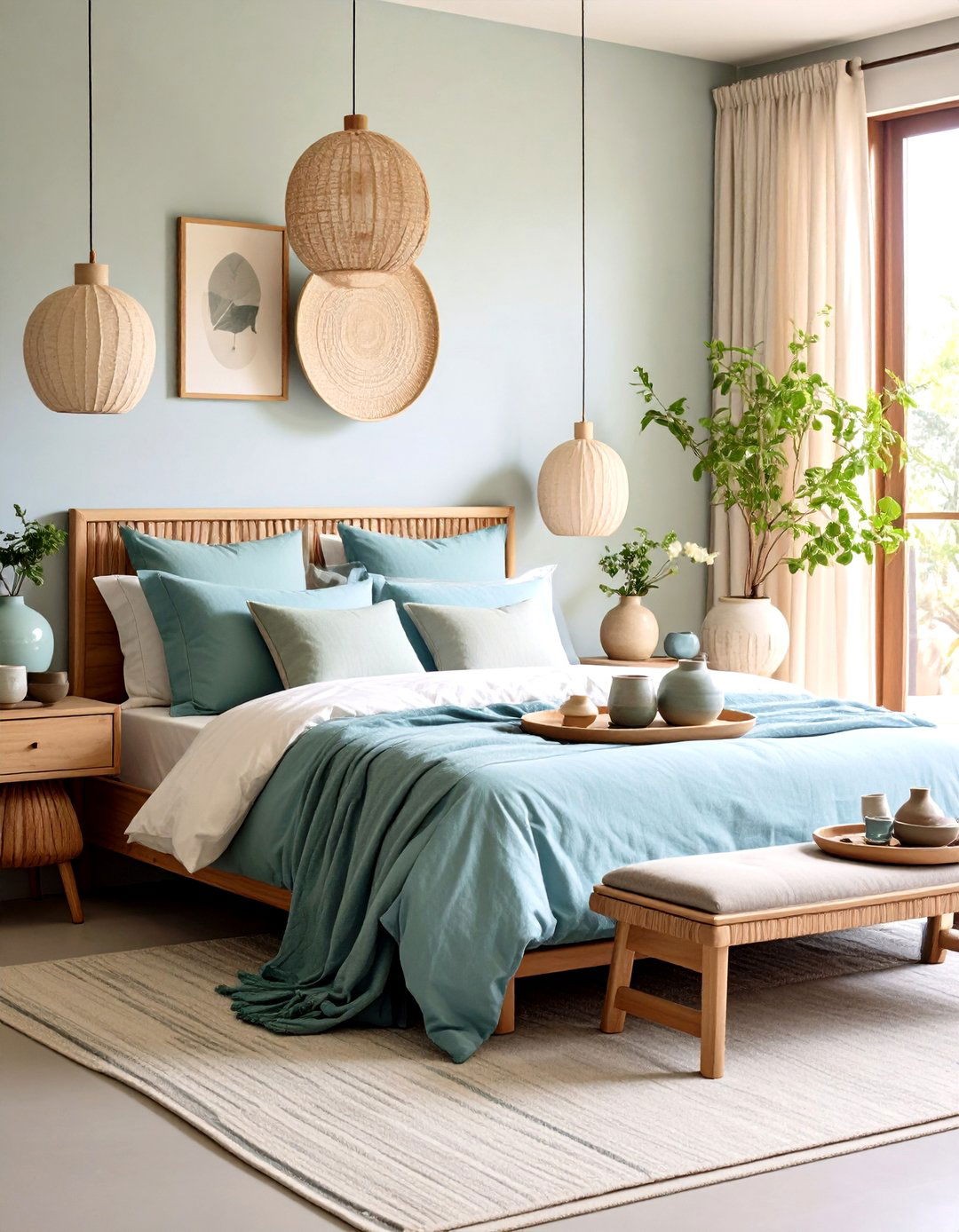
Showcase the beauty of imperfection through carefully selected handcrafted ceramic pieces that embody wabi-sabi principles while adding subtle visual interest to your space. Display pottery with organic shapes, uneven glazes, or visible maker's marks that celebrate human craftsmanship over machine perfection. Choose pieces in neutral tones like cream, beige, soft gray, or natural clay colors that harmonize with your overall palette. Group ceramics in odd numbers on floating shelves, nightstands, or dressers while leaving generous space around each piece to prevent visual clutter. Include functional items like ceramic planters, vases, or small bowls that serve practical purposes while maintaining aesthetic appeal. Consider pieces from local artisans that connect your space to your community and support traditional craftsmanship. The irregular beauty of handmade ceramics provides gentle focal points while supporting the Japandi appreciation for natural materials and authentic human expression. These elements add personality while maintaining the serene, contemplative atmosphere essential to restful bedroom environments.
18. Japandi Bedroom Geometric Pattern Integration

Incorporate subtle geometric patterns that add visual interest while maintaining the calm, balanced aesthetic central to Japandi bedroom design. Choose bedding with simple stripe patterns, grid designs, or subtle checks in neutral color combinations that create texture without overwhelming the peaceful atmosphere. Consider area rugs with minimal geometric motifs or simple border designs that define space while maintaining visual harmony. Introduce patterns through artwork featuring clean lines, circles, or abstract shapes in muted tones that complement your color palette. Keep patterns minimal and sophisticated, avoiding busy designs that create visual tension. Use the rule of threes: incorporate no more than three different patterns in varying scales to maintain balance and sophistication. Natural materials like wood grain and woven textures provide organic patterns that complement geometric elements without competition. This restrained approach to pattern adds depth and interest while supporting the meditative quality that makes Japandi bedrooms particularly conducive to rest and relaxation.
19. Japandi Bedroom Vertical Storage Solutions

Optimize your bedroom's vertical space through tall, narrow storage solutions that maintain floor openness while providing essential organization. Install floor-to-ceiling wardrobes with clean lines and minimal hardware that maximize storage capacity without overwhelming the space. Use tall, narrow dressers or modular shelving systems that draw the eye upward, creating the illusion of increased ceiling height. Consider wall-mounted storage that floats above eye level for seasonal items or rarely used belongings. Incorporate ladder-style shelving units made from natural wood that provide storage and display space while maintaining the organic aesthetic. Use vertical space behind doors for hanging organizers or slim storage cabinets that remain hidden when not in use. These solutions maintain the uncluttered floor space essential to Japandi design while ensuring adequate storage for modern living needs. The emphasis on height rather than width supports the minimalist principle of using space efficiently while maintaining the peaceful, open atmosphere that makes Japandi bedrooms particularly restful.
20. Japandi Bedroom Seasonal Decor Elements
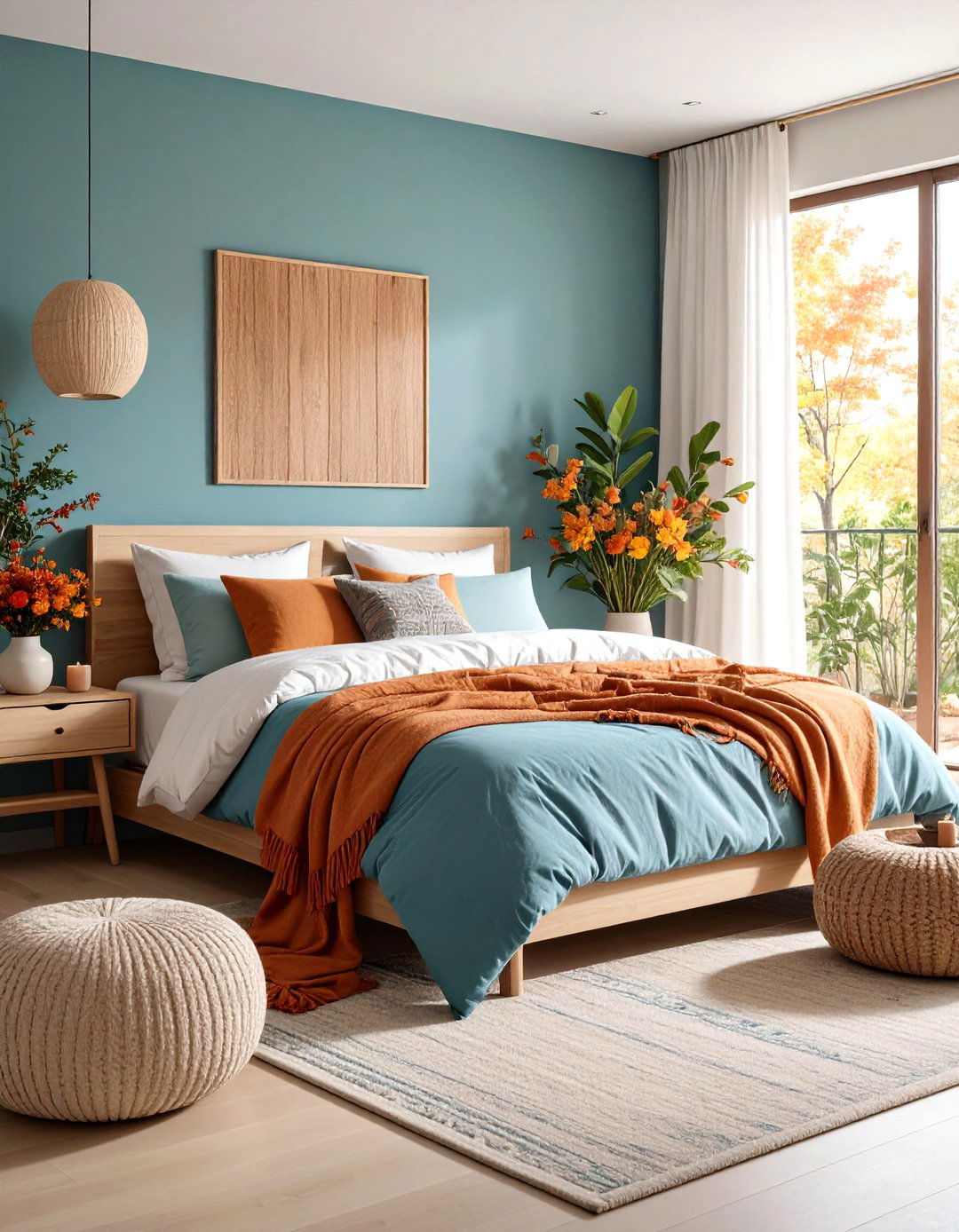
Embrace the natural rhythm of seasons through subtle decor changes that keep your bedroom feeling fresh while maintaining core Japandi design principles. Rotate throw pillows and blankets seasonally: lighter linens and cottons for spring and summer, warmer wools and heavier textures for fall and winter months. Change artwork or display items to reflect seasonal themes using natural elements like branches, stones, or dried flowers arranged in simple ceramic vessels. Adjust lighting to accommodate seasonal daylight changes, using candles or warmer bulbs during darker months for psychological comfort. Introduce seasonal colors subtly through small accessories: soft greens for spring, warm terracotta for autumn, while maintaining your neutral foundation. Consider seasonal plants that connect your space to natural cycles and provide changing visual interest throughout the year. These gentle modifications honor the Japandi connection to nature's rhythms while preventing your space from feeling static or stale, supporting the mindful awareness that makes this design philosophy particularly meaningful and sustainable.
Conclusion:
Japandi bedroom design offers a perfect synthesis of Eastern minimalism and Nordic warmth, creating spaces that truly support rest and renewal. By embracing natural materials, neutral palettes, and purposeful design choices, you transform your bedroom into a sanctuary that promotes both physical comfort and mental clarity. The key lies in selecting quality pieces that serve multiple functions while maintaining visual simplicity. Remember that Japandi style evolves with your needs, allowing for seasonal adjustments and personal growth while preserving core principles of mindfulness and connection to nature. These twenty design ideas provide a foundation for creating your own peaceful retreat that honors both aesthetic beauty and functional living.


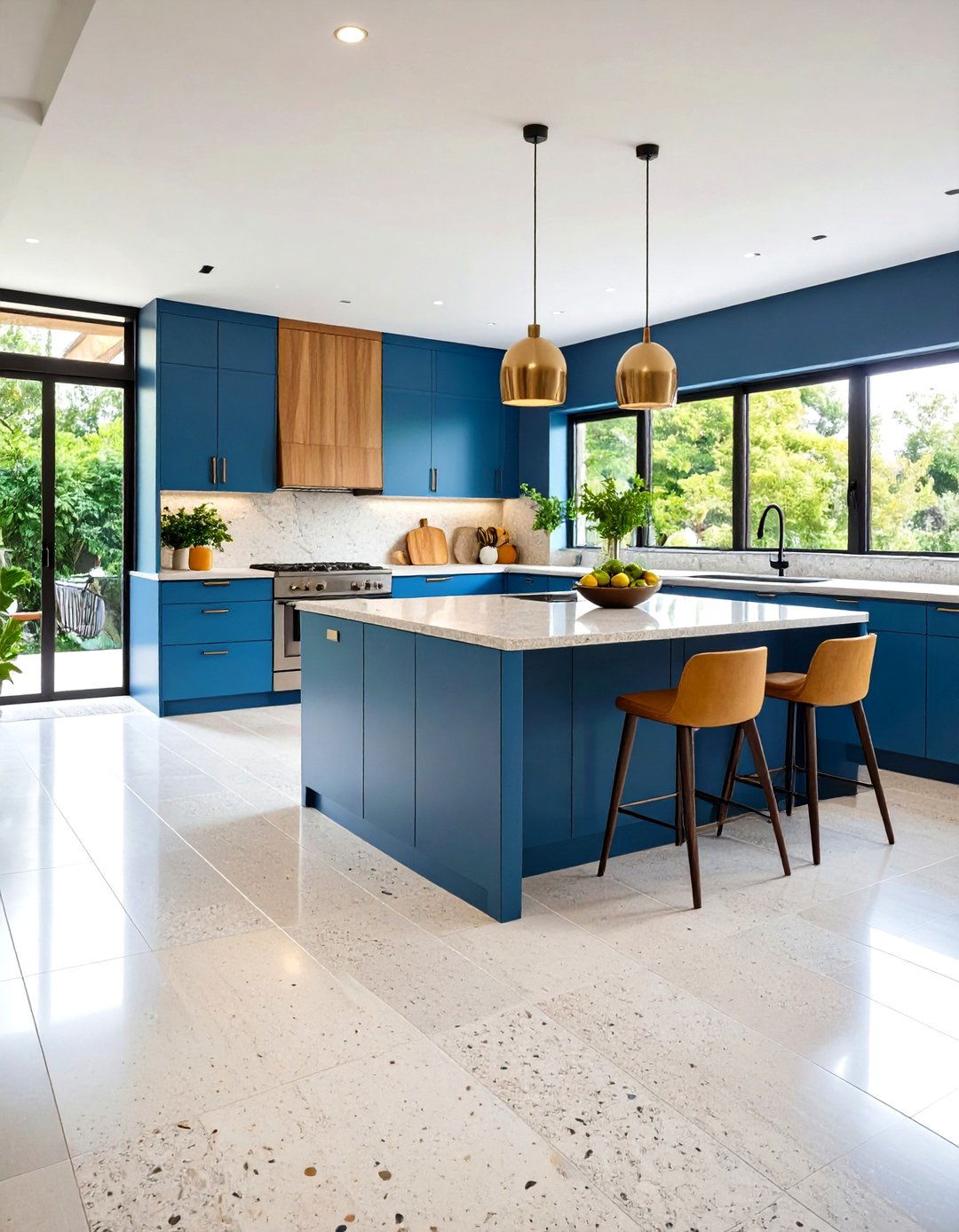
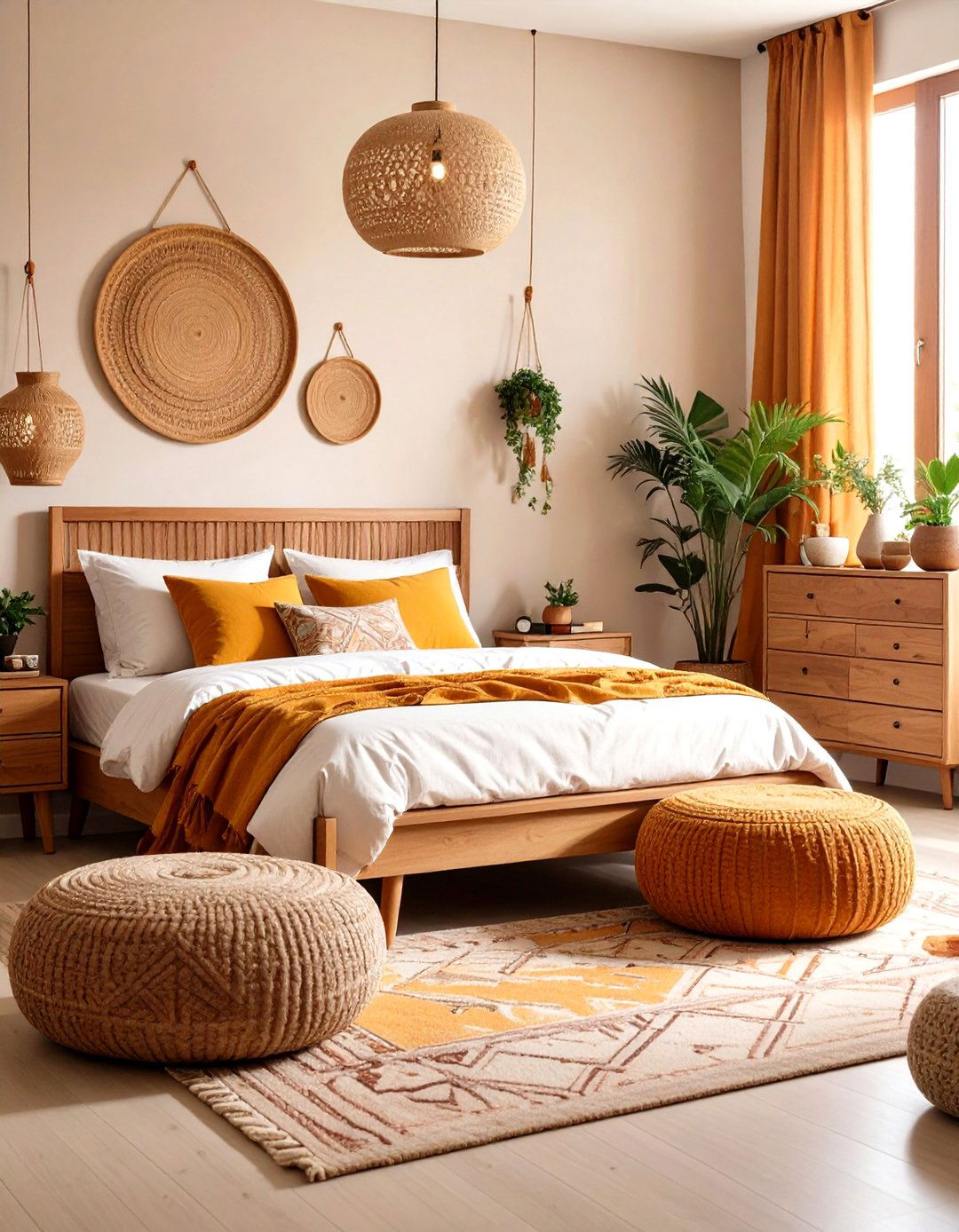

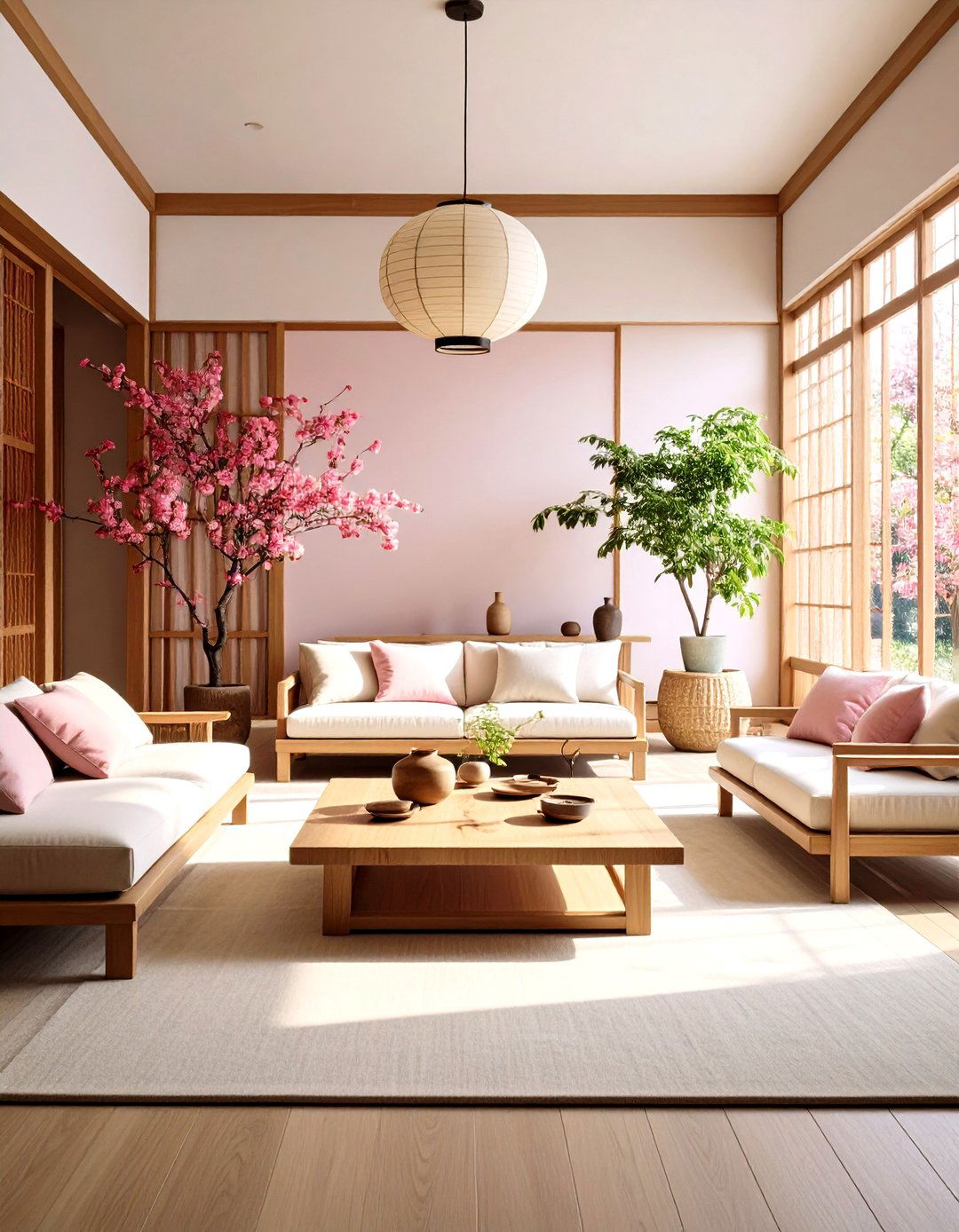
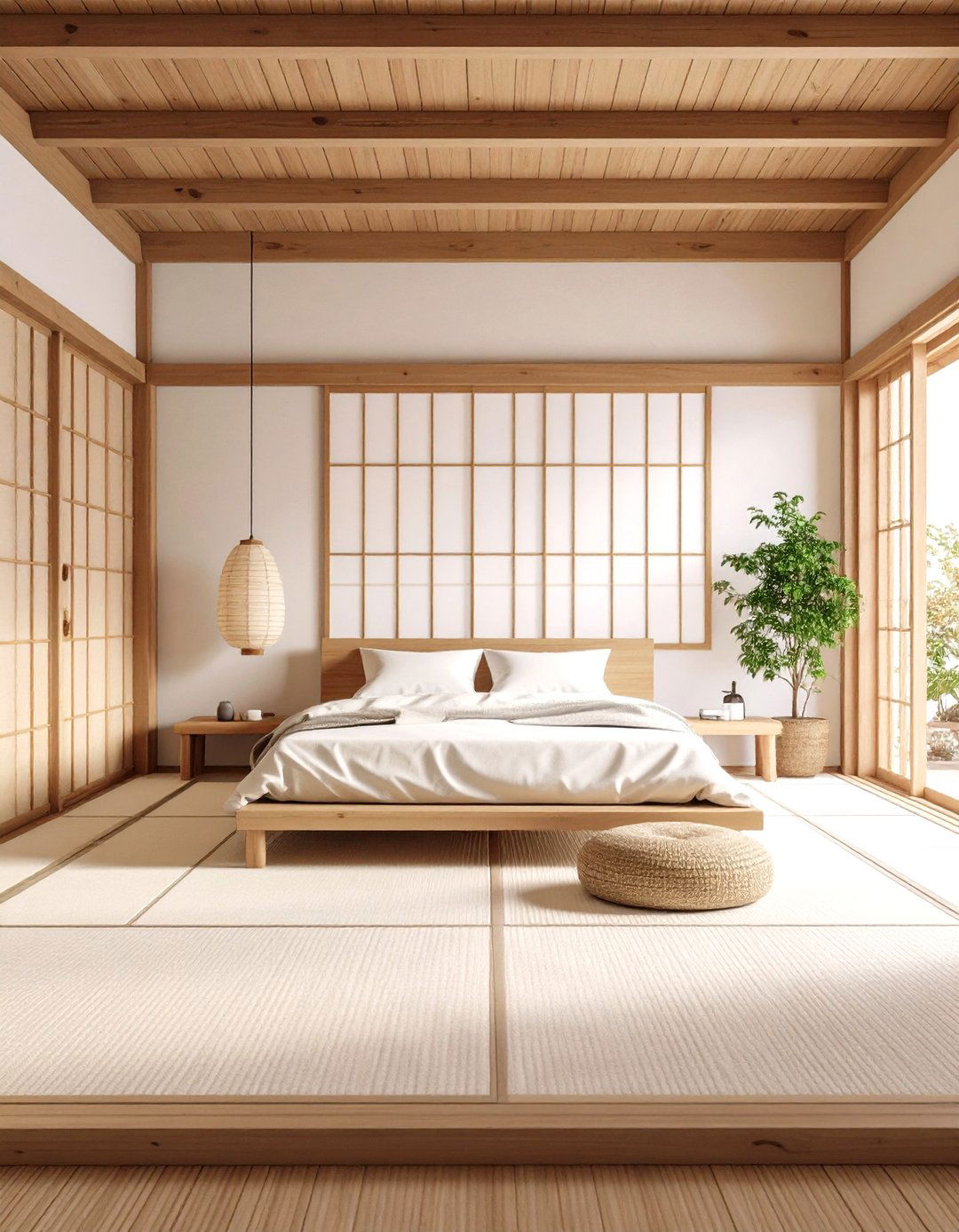


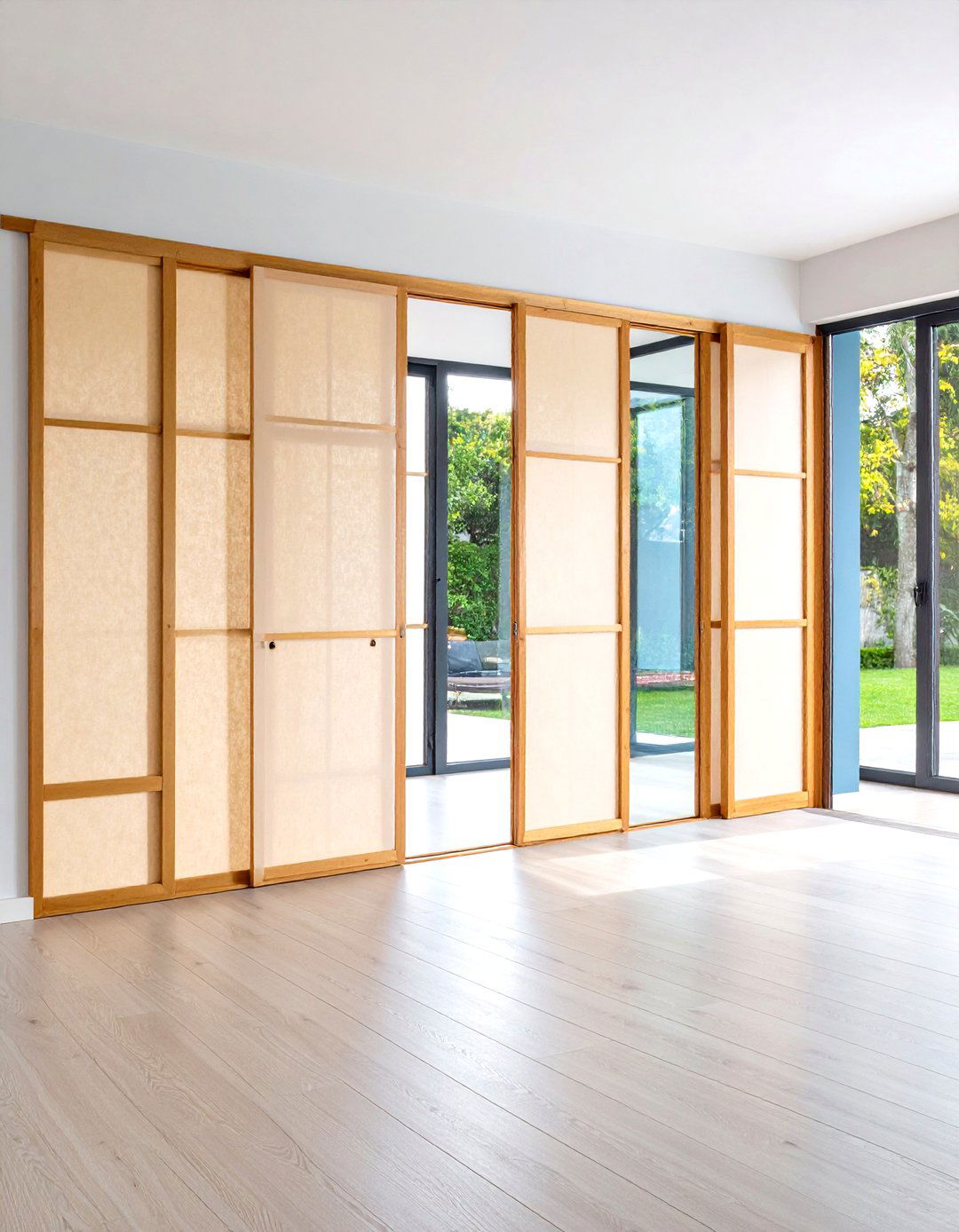
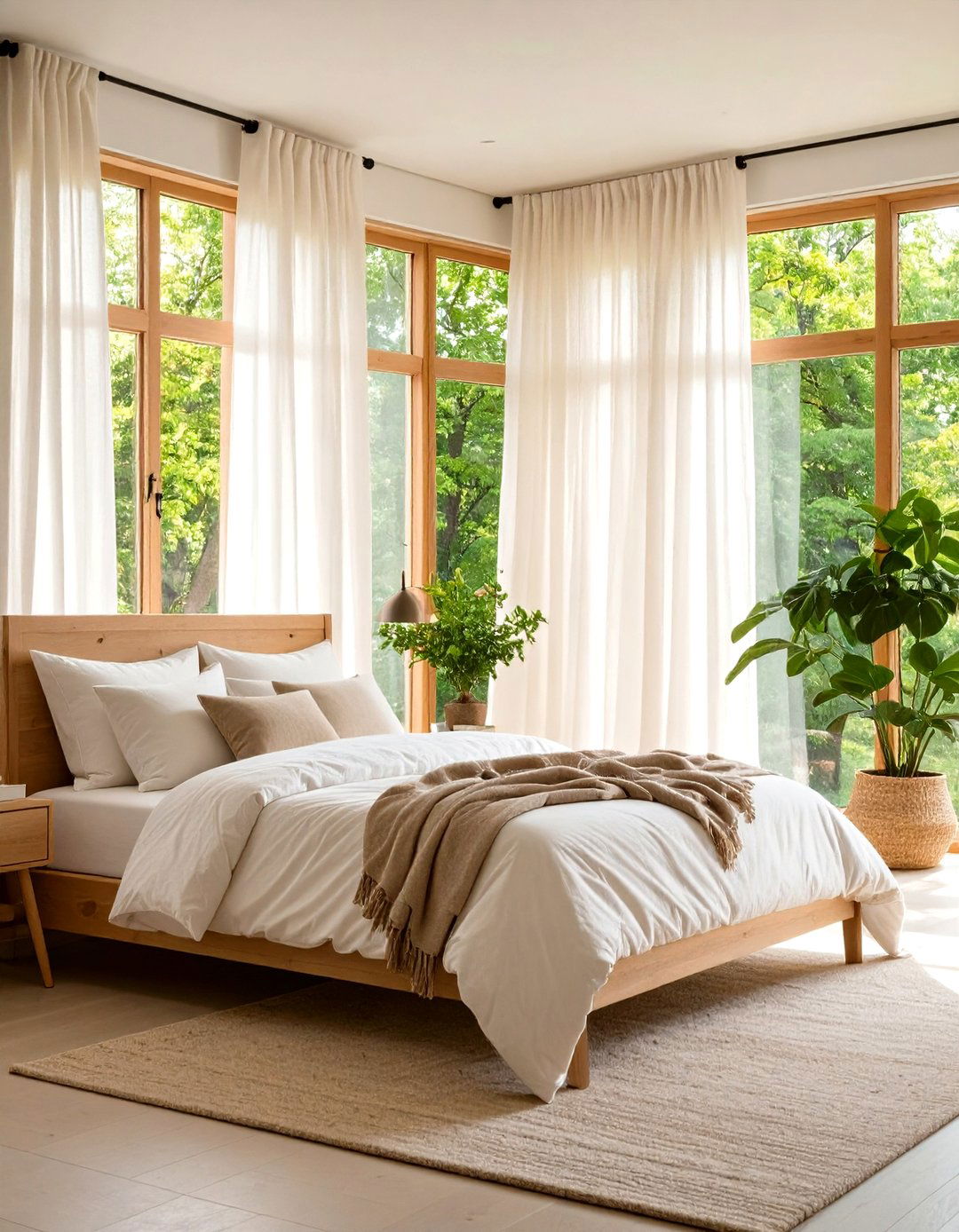
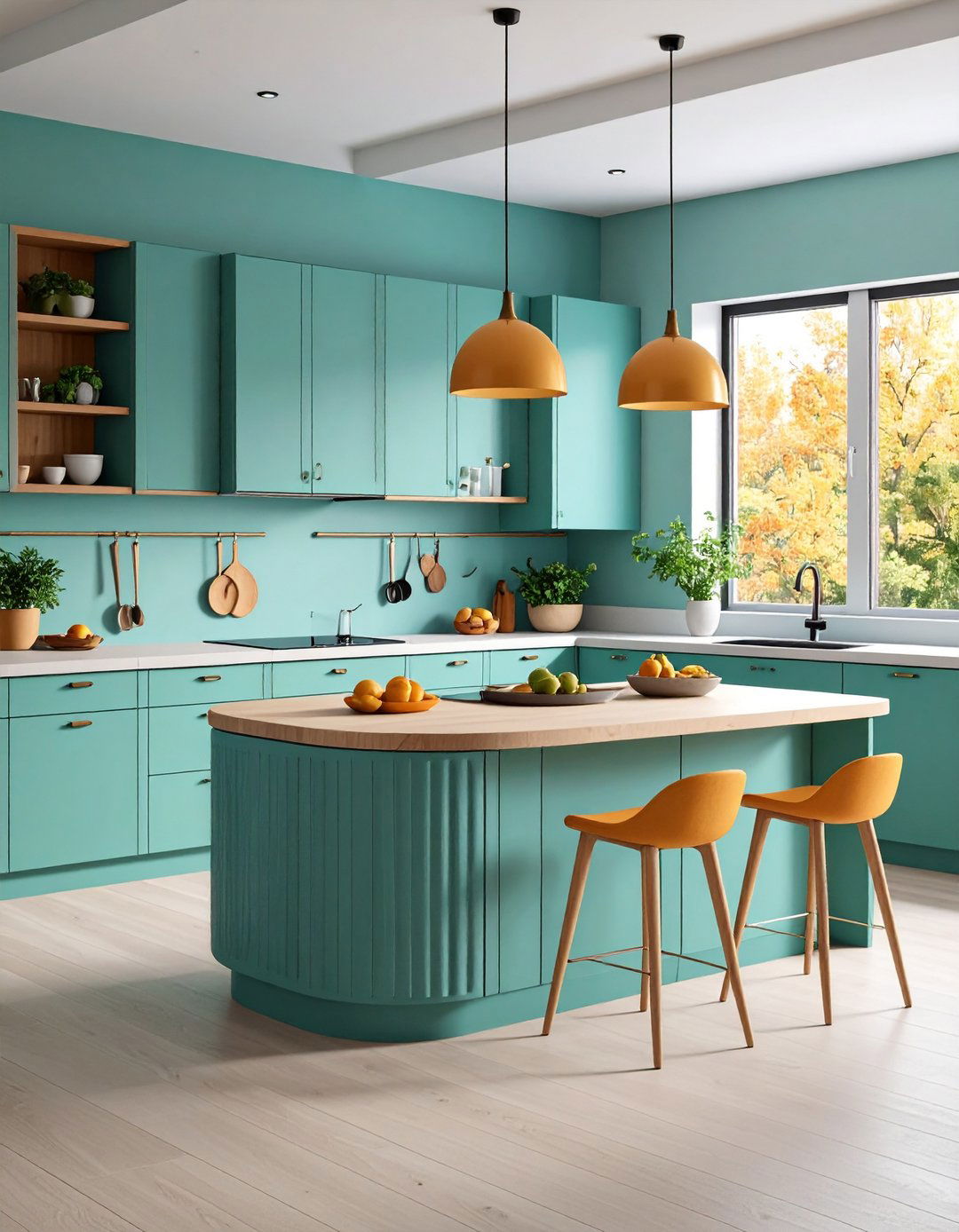
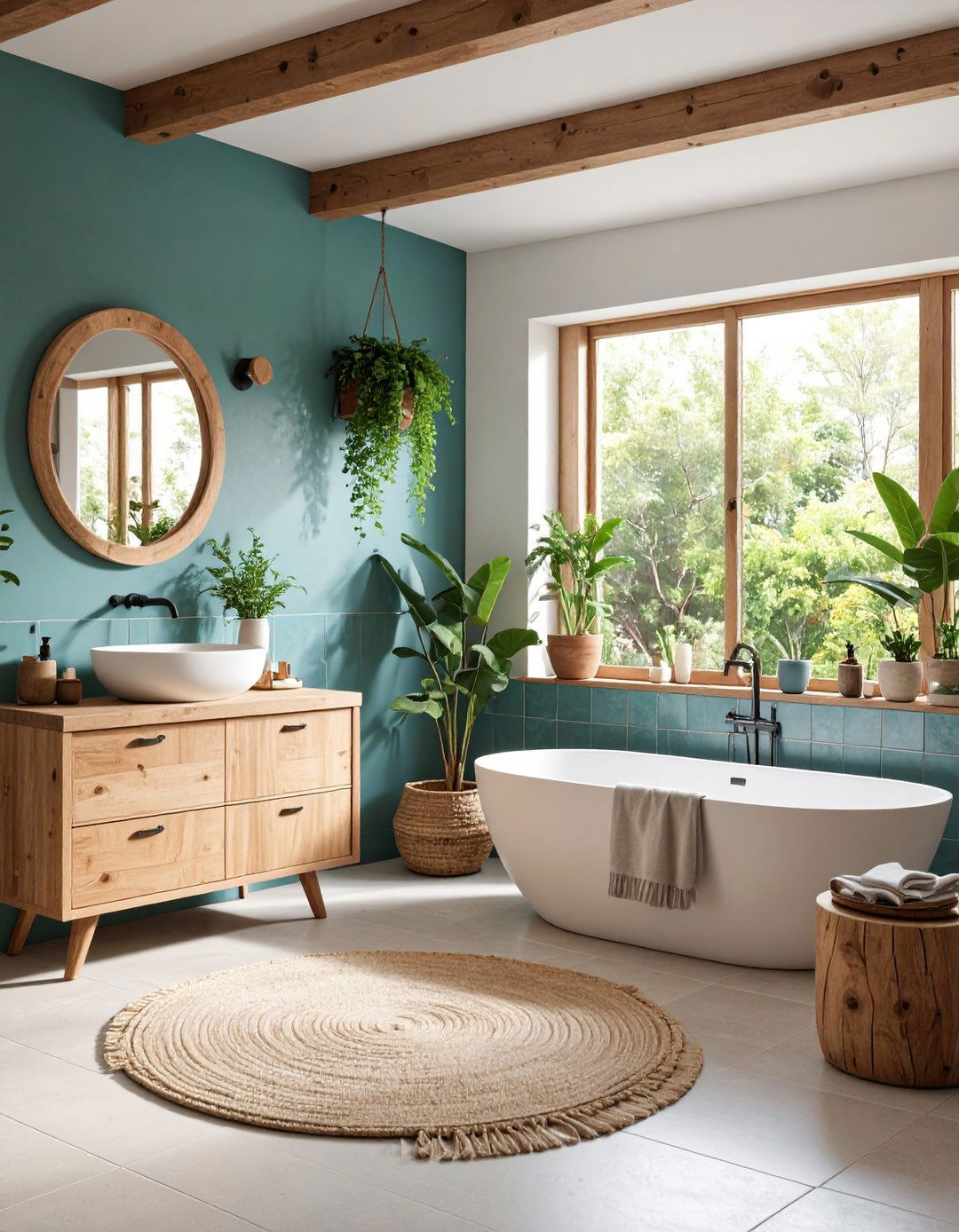
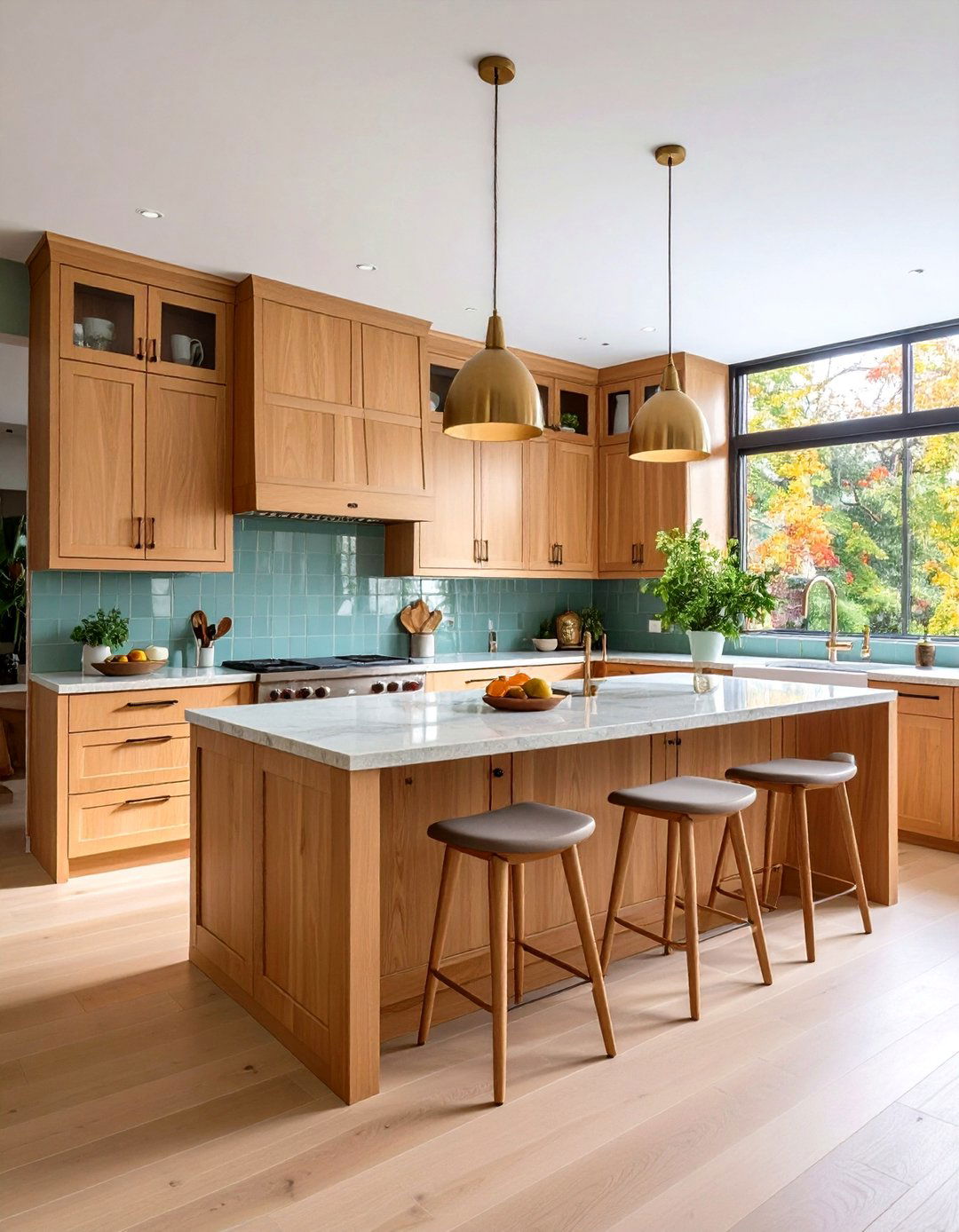

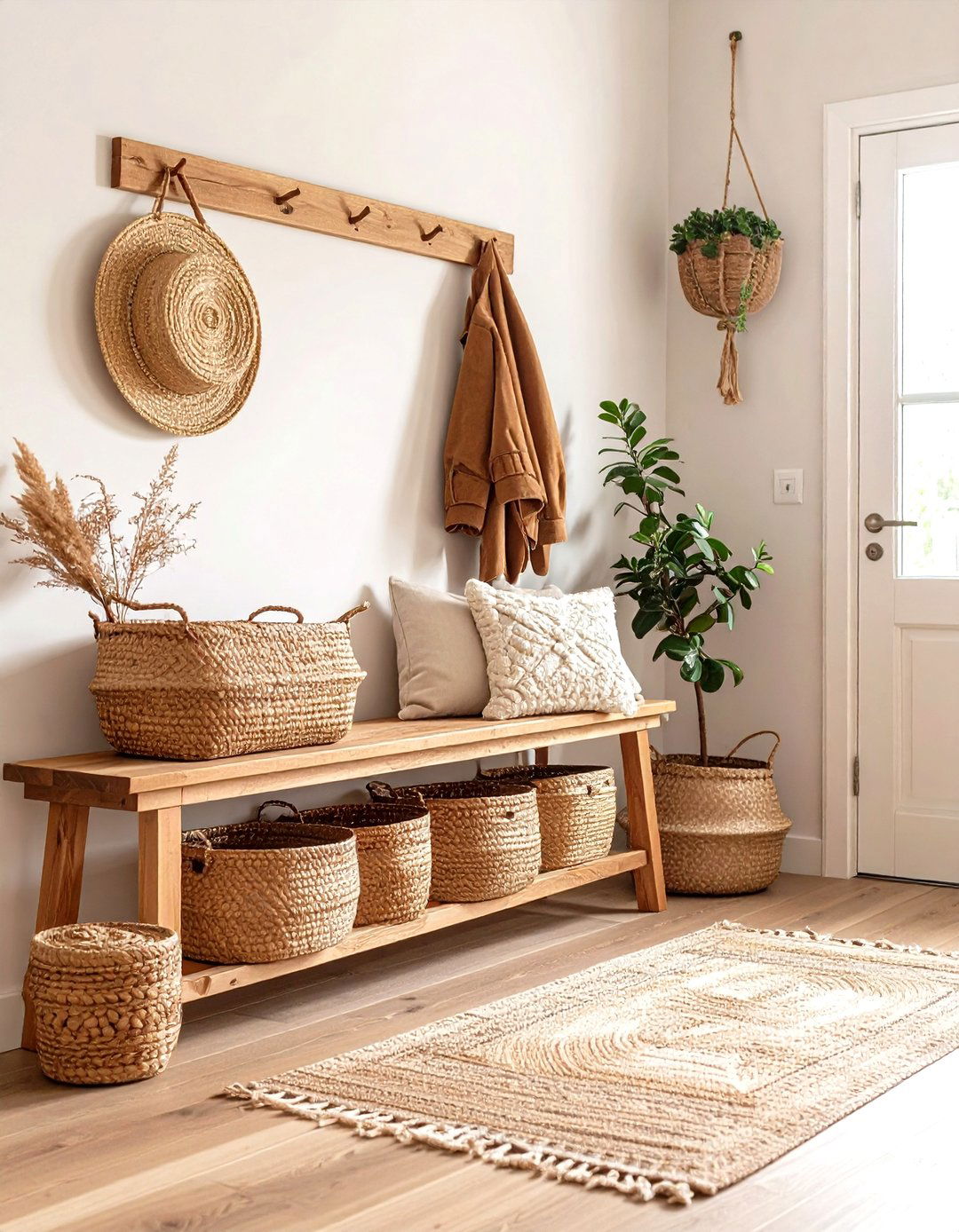
Leave a Reply